Ethical Philosophies and Impact on Business Assignment Report
VerifiedAdded on 2021/08/10
|22
|6501
|78
Report
AI Summary
This report, submitted by a student, examines the impact of ethical philosophies and ethical issues on business operations. It begins with an introduction to the business environment, followed by an analysis of the internal and external environments, including value systems, mission and objectives, structure, human resources, and corporate image. The report then delves into the macro environment using the PESTLE framework, illustrating both positive and negative impacts with examples. It also includes an internal and external analysis of Morrison using SWOT analysis, and discusses different market types such as perfect competition, monopoly, monopolistic competition, and oligopoly, along with opportunity cost. The report concludes with a summary of findings and a list of references. This report provides a comprehensive overview of the ethical and environmental factors influencing business decisions and performance.
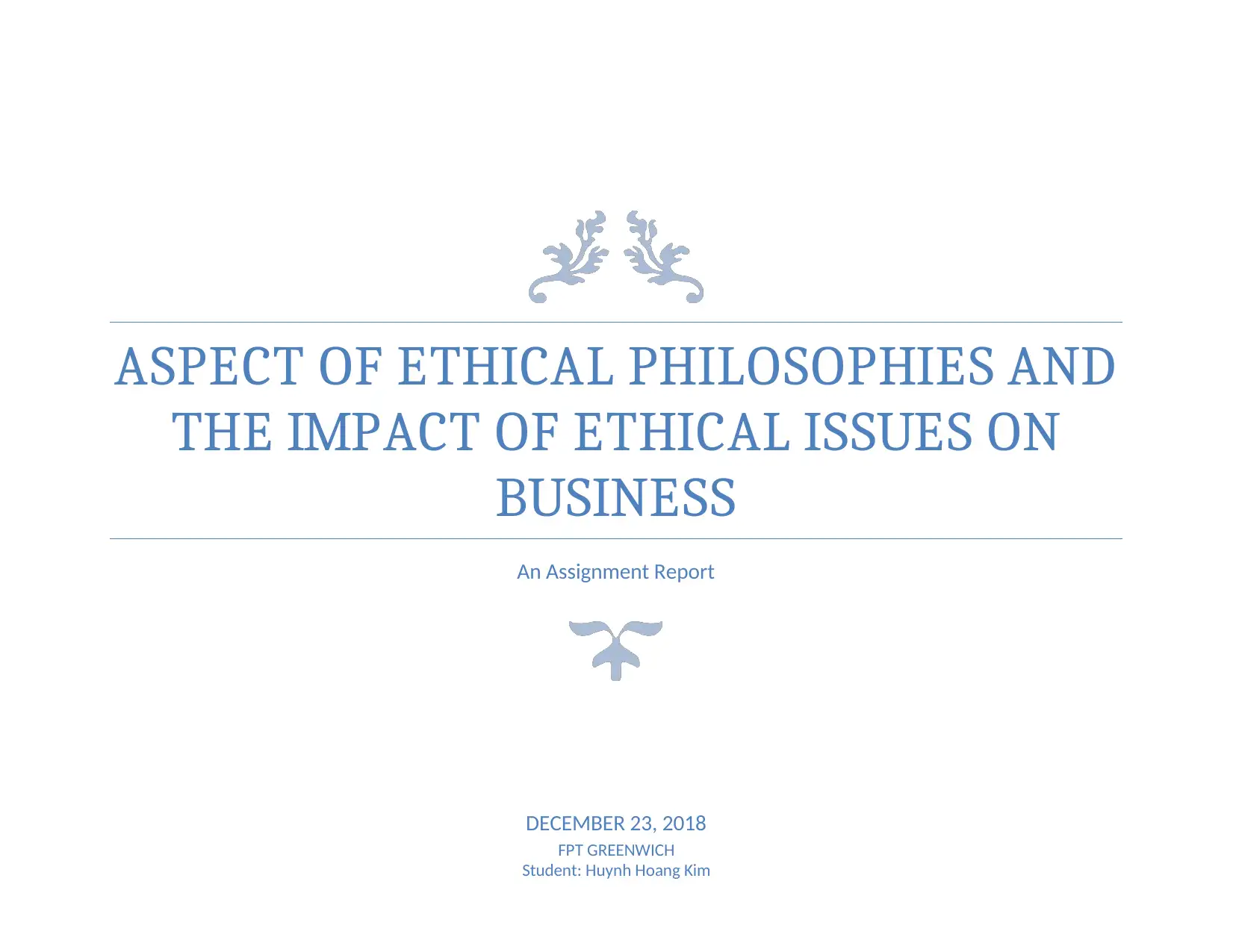
ASPECT OF ETHICAL PHILOSOPHIES AND
THE IMPACT OF ETHICAL ISSUES ON
BUSINESS
An Assignment Report
DECEMBER 23, 2018
FPT GREENWICH
Student: Huynh Hoang Kim
THE IMPACT OF ETHICAL ISSUES ON
BUSINESS
An Assignment Report
DECEMBER 23, 2018
FPT GREENWICH
Student: Huynh Hoang Kim
Paraphrase This Document
Need a fresh take? Get an instant paraphrase of this document with our AI Paraphraser

1 | P a g e
ASSIGNMENT FRONT SHEET <No.2>
Qualification BTEC Level 4 HND Diploma in Business
Unit number and title 485_Business and the Business Environment
Assignment due 23/12/2018 Assignment submitted 23/12/2018
Learner’s name Huynh Hoang Kim Learner’s code GBD18509
Class GBD0821 Assessor name Phan Tran Phuong Trang
Learner declaration:
I certify that the work submitted for this assignment is my own and research sources are fully acknowledged.
Learner signature Date
Grading grid
P4 P5 P6 M3 M4 D2
ASSIGNMENT FRONT SHEET <No.2>
Qualification BTEC Level 4 HND Diploma in Business
Unit number and title 485_Business and the Business Environment
Assignment due 23/12/2018 Assignment submitted 23/12/2018
Learner’s name Huynh Hoang Kim Learner’s code GBD18509
Class GBD0821 Assessor name Phan Tran Phuong Trang
Learner declaration:
I certify that the work submitted for this assignment is my own and research sources are fully acknowledged.
Learner signature Date
Grading grid
P4 P5 P6 M3 M4 D2

2 | P a g e
Assignment title Aspect of ethical philosophies and the impact of ethical issues on business
In this assignment, you will have opportunities to provide evidence against the following criteria.
Indicate the page numbers where the evidence can be found.
Assessment criteria Expected evidence Task
no.
Achieved (Stick to
mark as achieve)
LO3 Use contemporary examples to demonstrate both the positive and negative influence/impact the macro environment
has on business operations
Identify the positive and negative impacts the macro
environment has upon business operations, supported by
specific examples.
- The application of the PESTLE
framework
- How the macro environment
influences/impacts upon business
activities
- How organizations go through the
transformation process
P4
Assignment title Aspect of ethical philosophies and the impact of ethical issues on business
In this assignment, you will have opportunities to provide evidence against the following criteria.
Indicate the page numbers where the evidence can be found.
Assessment criteria Expected evidence Task
no.
Achieved (Stick to
mark as achieve)
LO3 Use contemporary examples to demonstrate both the positive and negative influence/impact the macro environment
has on business operations
Identify the positive and negative impacts the macro
environment has upon business operations, supported by
specific examples.
- The application of the PESTLE
framework
- How the macro environment
influences/impacts upon business
activities
- How organizations go through the
transformation process
P4
⊘ This is a preview!⊘
Do you want full access?
Subscribe today to unlock all pages.

Trusted by 1+ million students worldwide

3 | P a g e
LO4 Demonstrate the concepts of both internal and external analysis of organisations and explain the market type and
opportunity cost terms
Conduct internal and external analysis of specific
organizations in order to identify strengths and weaknesses.
- Introduction to SWOT and/or TOWS
analysis
- Internal and External Environments
P5
Explain how market types & opportunity cost work
Perfect competition, monopoly,
monopolistic competition and
oligopoly. Besides, analyse a
typical example with opportunity
cost.
P6
LO4 Demonstrate the concepts of both internal and external analysis of organisations and explain the market type and
opportunity cost terms
Conduct internal and external analysis of specific
organizations in order to identify strengths and weaknesses.
- Introduction to SWOT and/or TOWS
analysis
- Internal and External Environments
P5
Explain how market types & opportunity cost work
Perfect competition, monopoly,
monopolistic competition and
oligopoly. Besides, analyse a
typical example with opportunity
cost.
P6
Paraphrase This Document
Need a fresh take? Get an instant paraphrase of this document with our AI Paraphraser
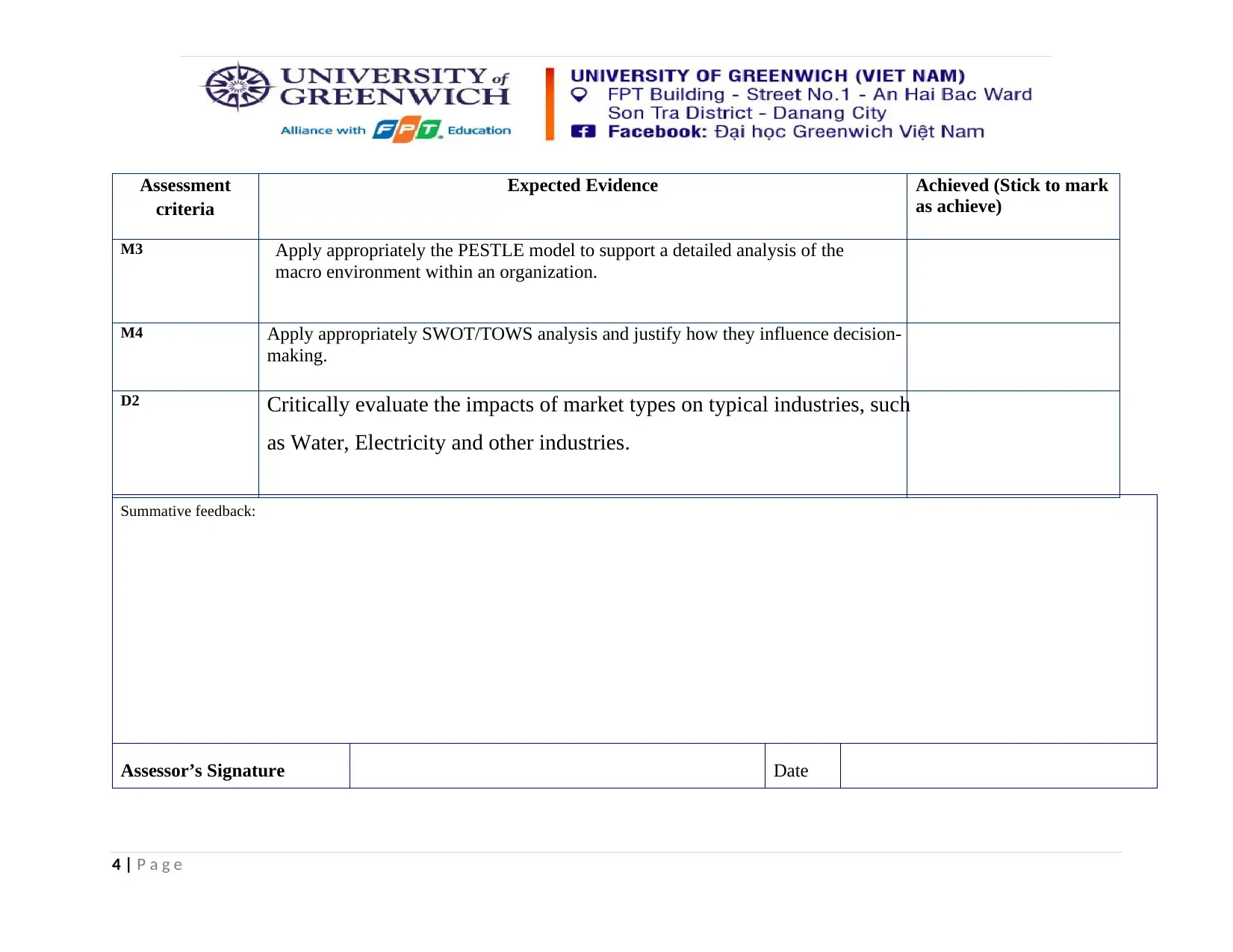
4 | P a g e
Assessment
criteria
Expected Evidence Achieved (Stick to mark
as achieve)
M3 Apply appropriately the PESTLE model to support a detailed analysis of the
macro environment within an organization.
M4 Apply appropriately SWOT/TOWS analysis and justify how they influence decision-
making.
D2 Critically evaluate the impacts of market types on typical industries, such
as Water, Electricity and other industries.
Summative feedback:
Assessor’s Signature Date
Assessment
criteria
Expected Evidence Achieved (Stick to mark
as achieve)
M3 Apply appropriately the PESTLE model to support a detailed analysis of the
macro environment within an organization.
M4 Apply appropriately SWOT/TOWS analysis and justify how they influence decision-
making.
D2 Critically evaluate the impacts of market types on typical industries, such
as Water, Electricity and other industries.
Summative feedback:
Assessor’s Signature Date
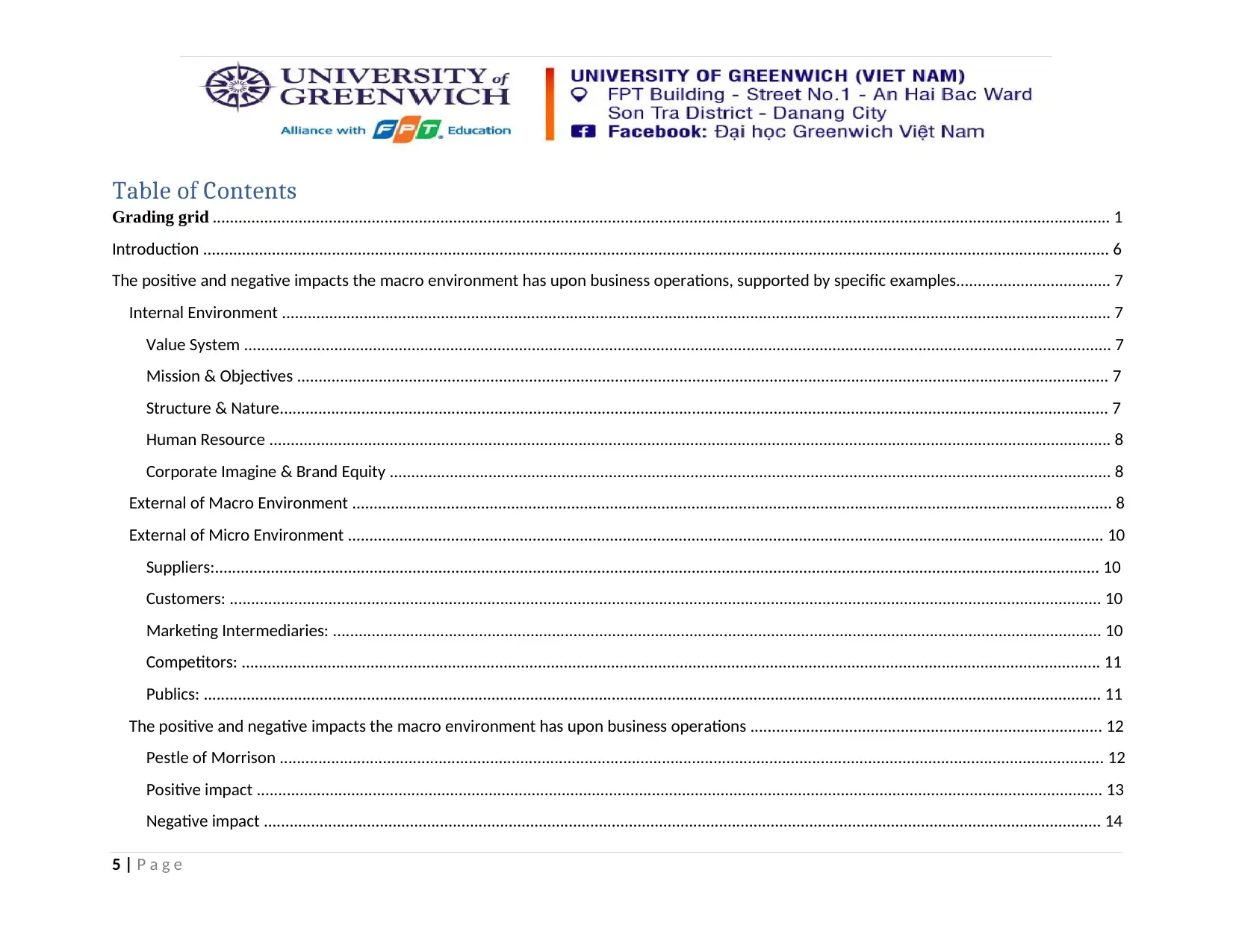
5 | P a g e
Table of Contents
Grading grid ................................................................................................................................................................................................................. 1
Introduction ................................................................................................................................................................................................................... 6
The positive and negative impacts the macro environment has upon business operations, supported by specific examples.................................... 7
Internal Environment ................................................................................................................................................................................................. 7
Value System .......................................................................................................................................................................................................... 7
Mission & Objectives ............................................................................................................................................................................................. 7
Structure & Nature................................................................................................................................................................................................. 7
Human Resource .................................................................................................................................................................................................... 8
Corporate Imagine & Brand Equity ........................................................................................................................................................................ 8
External of Macro Environment ................................................................................................................................................................................. 8
External of Micro Environment ................................................................................................................................................................................ 10
Suppliers:.............................................................................................................................................................................................................. 10
Customers: ........................................................................................................................................................................................................... 10
Marketing Intermediaries: ................................................................................................................................................................................... 10
Competitors: ........................................................................................................................................................................................................ 11
Publics: ................................................................................................................................................................................................................. 11
The positive and negative impacts the macro environment has upon business operations .................................................................................. 12
Pestle of Morrison ................................................................................................................................................................................................ 12
Positive impact ..................................................................................................................................................................................................... 13
Negative impact ................................................................................................................................................................................................... 14
Table of Contents
Grading grid ................................................................................................................................................................................................................. 1
Introduction ................................................................................................................................................................................................................... 6
The positive and negative impacts the macro environment has upon business operations, supported by specific examples.................................... 7
Internal Environment ................................................................................................................................................................................................. 7
Value System .......................................................................................................................................................................................................... 7
Mission & Objectives ............................................................................................................................................................................................. 7
Structure & Nature................................................................................................................................................................................................. 7
Human Resource .................................................................................................................................................................................................... 8
Corporate Imagine & Brand Equity ........................................................................................................................................................................ 8
External of Macro Environment ................................................................................................................................................................................. 8
External of Micro Environment ................................................................................................................................................................................ 10
Suppliers:.............................................................................................................................................................................................................. 10
Customers: ........................................................................................................................................................................................................... 10
Marketing Intermediaries: ................................................................................................................................................................................... 10
Competitors: ........................................................................................................................................................................................................ 11
Publics: ................................................................................................................................................................................................................. 11
The positive and negative impacts the macro environment has upon business operations .................................................................................. 12
Pestle of Morrison ................................................................................................................................................................................................ 12
Positive impact ..................................................................................................................................................................................................... 13
Negative impact ................................................................................................................................................................................................... 14
⊘ This is a preview!⊘
Do you want full access?
Subscribe today to unlock all pages.

Trusted by 1+ million students worldwide

6 | P a g e
Transformation Process ............................................................................................................................................................................................... 14
Conduct internal and external analysis of specific organizations in order to identify strengths and weaknesses ..................................................... 15
Internal analysis ................................................................................................................................................................................................... 15
External analysis ................................................................................................................................................................................................... 15
SWOT analysis: ............................................................................................................................................................................................................. 15
SWOT Analysis of Morrison ..................................................................................................................................................................................... 16
Market types and Opportunity Cost ............................................................................................................................................................................ 17
Perfect competition ................................................................................................................................................................................................. 17
Monopoly competition ............................................................................................................................................................................................ 17
Monopolistic competition ........................................................................................................................................................................................ 17
Oligopoly competition ............................................................................................................................................................................................. 18
Opportunity cost ...................................................................................................................................................................................................... 18
Conclusion .................................................................................................................................................................................................................... 19
References ................................................................................................................................................................................................................... 19
Introduction
The world today’s business environment is impacted by various factors and also influences the overall effectiveness of any
organizational and businesses performance. This assignment report will explain the positive and negative impacts the macro
environment has upon business operations, supported by specific examples. Furthermore, this assignment report will also explain
Transformation Process ............................................................................................................................................................................................... 14
Conduct internal and external analysis of specific organizations in order to identify strengths and weaknesses ..................................................... 15
Internal analysis ................................................................................................................................................................................................... 15
External analysis ................................................................................................................................................................................................... 15
SWOT analysis: ............................................................................................................................................................................................................. 15
SWOT Analysis of Morrison ..................................................................................................................................................................................... 16
Market types and Opportunity Cost ............................................................................................................................................................................ 17
Perfect competition ................................................................................................................................................................................................. 17
Monopoly competition ............................................................................................................................................................................................ 17
Monopolistic competition ........................................................................................................................................................................................ 17
Oligopoly competition ............................................................................................................................................................................................. 18
Opportunity cost ...................................................................................................................................................................................................... 18
Conclusion .................................................................................................................................................................................................................... 19
References ................................................................................................................................................................................................................... 19
Introduction
The world today’s business environment is impacted by various factors and also influences the overall effectiveness of any
organizational and businesses performance. This assignment report will explain the positive and negative impacts the macro
environment has upon business operations, supported by specific examples. Furthermore, this assignment report will also explain
Paraphrase This Document
Need a fresh take? Get an instant paraphrase of this document with our AI Paraphraser

7 | P a g e
the definition, and corresponding uses of various aspects of business environment such as Pestle and SWOT analysis to help develop
understanding about the ways that companies can be influenced by the business environment.
The positive and negative impacts the macro environment has upon business operations, supported by specific examples.
Internal Environment
Value System
The interconnection of processes and activities within and among organizations involve in the production and delivering of an
offering that create benefits for intermediaries and end consumers, which strongly relating to the selection of business, the mission,
and objectives of the organization, business policies, and practices.
Mission & Objectives
The business domain of the corporate, priorities, the direction of development, business philosophy, business policy, are guided by
the mission and objectives of the corporate.
Structure & Nature
The authoritative structure, Board of Directors, and executive which govern over the company. Governing body is the most basic
requirement and utmost important, which is essential the brain of the company. The shareholding example can likewise have
imperative administrative ramifications.
the definition, and corresponding uses of various aspects of business environment such as Pestle and SWOT analysis to help develop
understanding about the ways that companies can be influenced by the business environment.
The positive and negative impacts the macro environment has upon business operations, supported by specific examples.
Internal Environment
Value System
The interconnection of processes and activities within and among organizations involve in the production and delivering of an
offering that create benefits for intermediaries and end consumers, which strongly relating to the selection of business, the mission,
and objectives of the organization, business policies, and practices.
Mission & Objectives
The business domain of the corporate, priorities, the direction of development, business philosophy, business policy, are guided by
the mission and objectives of the corporate.
Structure & Nature
The authoritative structure, Board of Directors, and executive which govern over the company. Governing body is the most basic
requirement and utmost important, which is essential the brain of the company. The shareholding example can likewise have
imperative administrative ramifications.

8 | P a g e
Human Resource
The attributes of Human Resource like attitude, quality, skills, etc., can add to the efficiency and shortcoming of the organization.
The contribution, activity and so forth of the employees at various categories may differ from organization to organization.
Corporate Imagine & Brand Equity
The image of the organization matters as it ultimately represent the credibility of the company while raising money, framing joint
endeavors or different unions, requesting market intermediaries, entering buy or deal contracts, propelling new products etc.
External of Macro Environment
• Political Factors: The political factors play an important role to determine how the McDonald corporation will organize its
activities. The major aspect of this factor is the government which is ruling the nation, i.e. USA, policies as formulated by
them is to be made sure that they are being applied and followed accordingly (Grimsley, 2013). This factor is very important
as the company might face consequences, which will lead to a harmful defect in the company if they were not aware of their
law-breaking actions. Hence, it is advisable for all the companies to follow the policies as generated by the ruling government
in that country. McDonald, consequently, has laid down its objectives as per the policies of the government.
• Socio-Cultural Factors: Apart from the political factors, the socio-cultural factors also play an important role for the
organization to set its objectives in the long run. Every country has its own cultural setting and belief, which should be
followed at the time when the company is actually operating in any nation, or else, the company may face the wrath of the
people of that culture and society. Hence, these socio-cultural factors do play an important role in the total activities of the
company (Grimsley, 2013).
Human Resource
The attributes of Human Resource like attitude, quality, skills, etc., can add to the efficiency and shortcoming of the organization.
The contribution, activity and so forth of the employees at various categories may differ from organization to organization.
Corporate Imagine & Brand Equity
The image of the organization matters as it ultimately represent the credibility of the company while raising money, framing joint
endeavors or different unions, requesting market intermediaries, entering buy or deal contracts, propelling new products etc.
External of Macro Environment
• Political Factors: The political factors play an important role to determine how the McDonald corporation will organize its
activities. The major aspect of this factor is the government which is ruling the nation, i.e. USA, policies as formulated by
them is to be made sure that they are being applied and followed accordingly (Grimsley, 2013). This factor is very important
as the company might face consequences, which will lead to a harmful defect in the company if they were not aware of their
law-breaking actions. Hence, it is advisable for all the companies to follow the policies as generated by the ruling government
in that country. McDonald, consequently, has laid down its objectives as per the policies of the government.
• Socio-Cultural Factors: Apart from the political factors, the socio-cultural factors also play an important role for the
organization to set its objectives in the long run. Every country has its own cultural setting and belief, which should be
followed at the time when the company is actually operating in any nation, or else, the company may face the wrath of the
people of that culture and society. Hence, these socio-cultural factors do play an important role in the total activities of the
company (Grimsley, 2013).
⊘ This is a preview!⊘
Do you want full access?
Subscribe today to unlock all pages.

Trusted by 1+ million students worldwide

9 | P a g e
• Educational factors: Apart from the above-mentioned factors, education is also considered as one of the major factors which
determines the existence of the organization. Many firms provide their own training for their employees, then hire the
people who have taken training from them. These educational aspects are the major factors, which should be considered as
without their existence, the company will not be performing in the best possible manner (Grimsley, 2013).
• Technological Factors: These are external factors as well which affects the daily activities of the company. The technology is
essentially the main problems in which several firms are concerned in competition. The technology is that the most
significant issue to work out the performance of the corporate. These factors square measure essentially on the far side the
management of the businesses and thus all the businesses, including shell will have to be sure of the facts that these
technologies are being utilized appropriately (Grimsley, 2013).
• Legal Factors: Not only does the technology, legal factors are also considered to be the external factors. Legal factors
embody the law associated with the businesses act, and regulate up to what extent a corporation will take its activities.
Anything beyond the legal factors performed by the company will be reported against and strict action can be taken against
the companies, by the authorities (Grimsley, 2013).
• Environmental Factors: The environmental factors also are considered an important external force, which affect the
operation of the company. It is important for the company to make sure that they do not perform any activities, which are
against the environment or affect the environment adversely (Grimsley, 2013). Hence, it can be said that the environment
plays an important role in determining the activities of the company, and where the company will go.
• Educational factors: Apart from the above-mentioned factors, education is also considered as one of the major factors which
determines the existence of the organization. Many firms provide their own training for their employees, then hire the
people who have taken training from them. These educational aspects are the major factors, which should be considered as
without their existence, the company will not be performing in the best possible manner (Grimsley, 2013).
• Technological Factors: These are external factors as well which affects the daily activities of the company. The technology is
essentially the main problems in which several firms are concerned in competition. The technology is that the most
significant issue to work out the performance of the corporate. These factors square measure essentially on the far side the
management of the businesses and thus all the businesses, including shell will have to be sure of the facts that these
technologies are being utilized appropriately (Grimsley, 2013).
• Legal Factors: Not only does the technology, legal factors are also considered to be the external factors. Legal factors
embody the law associated with the businesses act, and regulate up to what extent a corporation will take its activities.
Anything beyond the legal factors performed by the company will be reported against and strict action can be taken against
the companies, by the authorities (Grimsley, 2013).
• Environmental Factors: The environmental factors also are considered an important external force, which affect the
operation of the company. It is important for the company to make sure that they do not perform any activities, which are
against the environment or affect the environment adversely (Grimsley, 2013). Hence, it can be said that the environment
plays an important role in determining the activities of the company, and where the company will go.
Paraphrase This Document
Need a fresh take? Get an instant paraphrase of this document with our AI Paraphraser
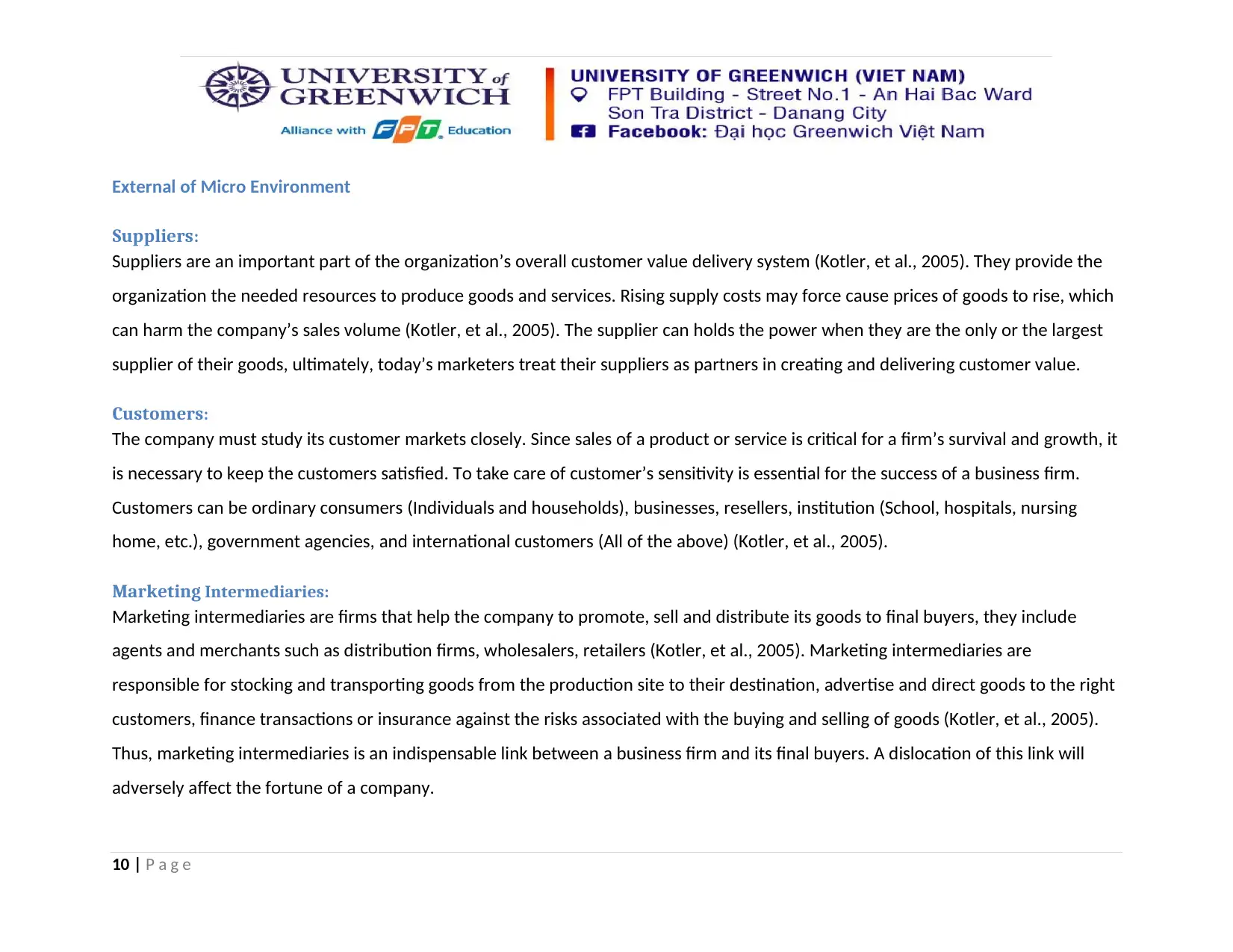
10 | P a g e
External of Micro Environment
Suppliers:
Suppliers are an important part of the organization’s overall customer value delivery system (Kotler, et al., 2005). They provide the
organization the needed resources to produce goods and services. Rising supply costs may force cause prices of goods to rise, which
can harm the company’s sales volume (Kotler, et al., 2005). The supplier can holds the power when they are the only or the largest
supplier of their goods, ultimately, today’s marketers treat their suppliers as partners in creating and delivering customer value.
Customers:
The company must study its customer markets closely. Since sales of a product or service is critical for a firm’s survival and growth, it
is necessary to keep the customers satisfied. To take care of customer’s sensitivity is essential for the success of a business firm.
Customers can be ordinary consumers (Individuals and households), businesses, resellers, institution (School, hospitals, nursing
home, etc.), government agencies, and international customers (All of the above) (Kotler, et al., 2005).
Marketing Intermediaries:
Marketing intermediaries are firms that help the company to promote, sell and distribute its goods to final buyers, they include
agents and merchants such as distribution firms, wholesalers, retailers (Kotler, et al., 2005). Marketing intermediaries are
responsible for stocking and transporting goods from the production site to their destination, advertise and direct goods to the right
customers, finance transactions or insurance against the risks associated with the buying and selling of goods (Kotler, et al., 2005).
Thus, marketing intermediaries is an indispensable link between a business firm and its final buyers. A dislocation of this link will
adversely affect the fortune of a company.
External of Micro Environment
Suppliers:
Suppliers are an important part of the organization’s overall customer value delivery system (Kotler, et al., 2005). They provide the
organization the needed resources to produce goods and services. Rising supply costs may force cause prices of goods to rise, which
can harm the company’s sales volume (Kotler, et al., 2005). The supplier can holds the power when they are the only or the largest
supplier of their goods, ultimately, today’s marketers treat their suppliers as partners in creating and delivering customer value.
Customers:
The company must study its customer markets closely. Since sales of a product or service is critical for a firm’s survival and growth, it
is necessary to keep the customers satisfied. To take care of customer’s sensitivity is essential for the success of a business firm.
Customers can be ordinary consumers (Individuals and households), businesses, resellers, institution (School, hospitals, nursing
home, etc.), government agencies, and international customers (All of the above) (Kotler, et al., 2005).
Marketing Intermediaries:
Marketing intermediaries are firms that help the company to promote, sell and distribute its goods to final buyers, they include
agents and merchants such as distribution firms, wholesalers, retailers (Kotler, et al., 2005). Marketing intermediaries are
responsible for stocking and transporting goods from the production site to their destination, advertise and direct goods to the right
customers, finance transactions or insurance against the risks associated with the buying and selling of goods (Kotler, et al., 2005).
Thus, marketing intermediaries is an indispensable link between a business firm and its final buyers. A dislocation of this link will
adversely affect the fortune of a company.
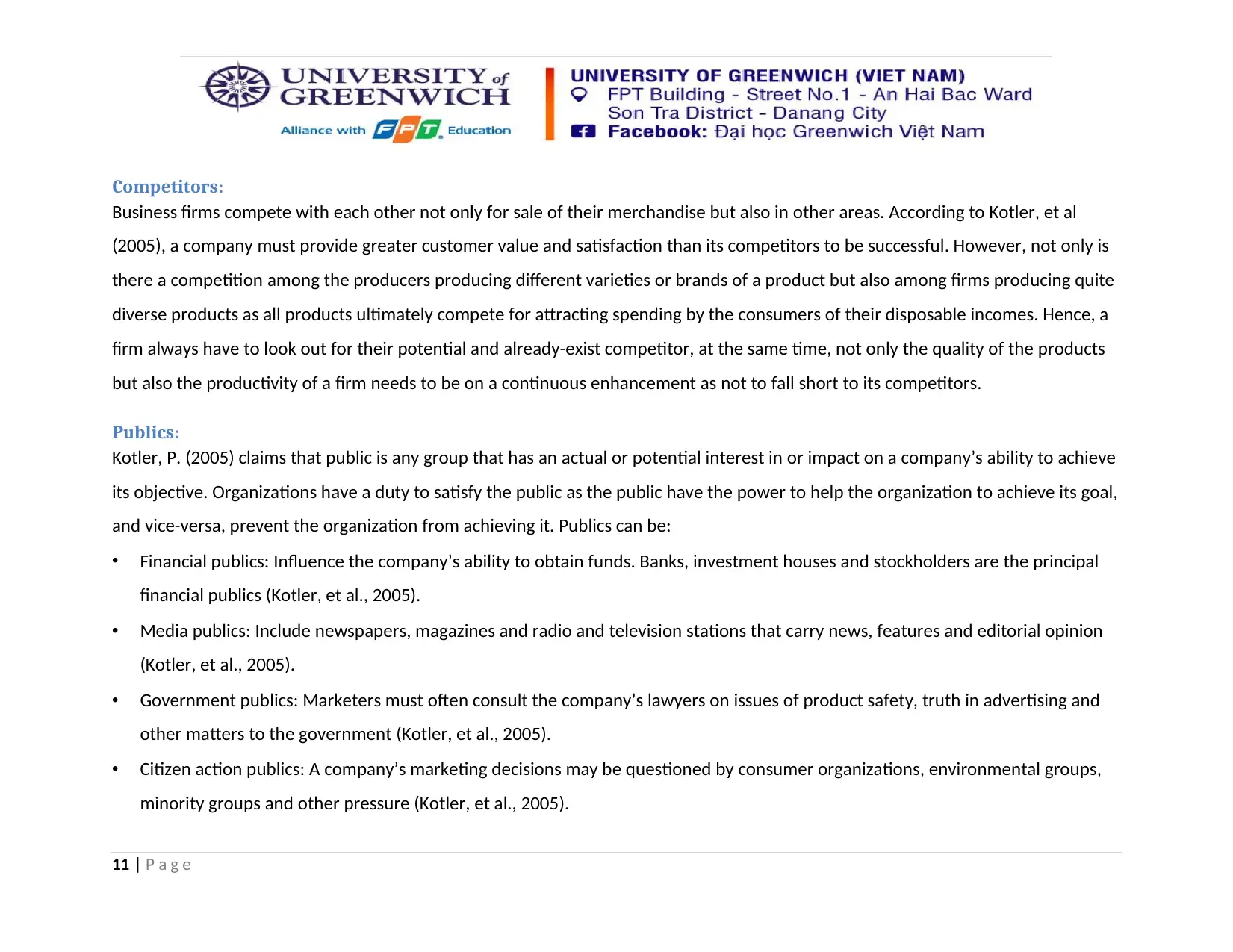
11 | P a g e
Competitors:
Business firms compete with each other not only for sale of their merchandise but also in other areas. According to Kotler, et al
(2005), a company must provide greater customer value and satisfaction than its competitors to be successful. However, not only is
there a competition among the producers producing different varieties or brands of a product but also among firms producing quite
diverse products as all products ultimately compete for attracting spending by the consumers of their disposable incomes. Hence, a
firm always have to look out for their potential and already-exist competitor, at the same time, not only the quality of the products
but also the productivity of a firm needs to be on a continuous enhancement as not to fall short to its competitors.
Publics:
Kotler, P. (2005) claims that public is any group that has an actual or potential interest in or impact on a company’s ability to achieve
its objective. Organizations have a duty to satisfy the public as the public have the power to help the organization to achieve its goal,
and vice-versa, prevent the organization from achieving it. Publics can be:
• Financial publics: Influence the company’s ability to obtain funds. Banks, investment houses and stockholders are the principal
financial publics (Kotler, et al., 2005).
• Media publics: Include newspapers, magazines and radio and television stations that carry news, features and editorial opinion
(Kotler, et al., 2005).
• Government publics: Marketers must often consult the company’s lawyers on issues of product safety, truth in advertising and
other matters to the government (Kotler, et al., 2005).
• Citizen action publics: A company’s marketing decisions may be questioned by consumer organizations, environmental groups,
minority groups and other pressure (Kotler, et al., 2005).
Competitors:
Business firms compete with each other not only for sale of their merchandise but also in other areas. According to Kotler, et al
(2005), a company must provide greater customer value and satisfaction than its competitors to be successful. However, not only is
there a competition among the producers producing different varieties or brands of a product but also among firms producing quite
diverse products as all products ultimately compete for attracting spending by the consumers of their disposable incomes. Hence, a
firm always have to look out for their potential and already-exist competitor, at the same time, not only the quality of the products
but also the productivity of a firm needs to be on a continuous enhancement as not to fall short to its competitors.
Publics:
Kotler, P. (2005) claims that public is any group that has an actual or potential interest in or impact on a company’s ability to achieve
its objective. Organizations have a duty to satisfy the public as the public have the power to help the organization to achieve its goal,
and vice-versa, prevent the organization from achieving it. Publics can be:
• Financial publics: Influence the company’s ability to obtain funds. Banks, investment houses and stockholders are the principal
financial publics (Kotler, et al., 2005).
• Media publics: Include newspapers, magazines and radio and television stations that carry news, features and editorial opinion
(Kotler, et al., 2005).
• Government publics: Marketers must often consult the company’s lawyers on issues of product safety, truth in advertising and
other matters to the government (Kotler, et al., 2005).
• Citizen action publics: A company’s marketing decisions may be questioned by consumer organizations, environmental groups,
minority groups and other pressure (Kotler, et al., 2005).
⊘ This is a preview!⊘
Do you want full access?
Subscribe today to unlock all pages.

Trusted by 1+ million students worldwide
1 out of 22
Related Documents
Your All-in-One AI-Powered Toolkit for Academic Success.
+13062052269
info@desklib.com
Available 24*7 on WhatsApp / Email
![[object Object]](/_next/static/media/star-bottom.7253800d.svg)
Unlock your academic potential
Copyright © 2020–2025 A2Z Services. All Rights Reserved. Developed and managed by ZUCOL.





